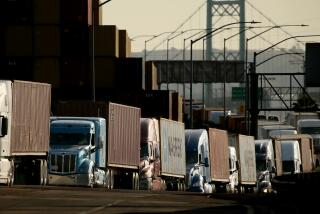Idle cars signal a downturn
- Share via
CRAIG, MONT. — The nation’s top hauler of container rail freight, BNSF Railway Co., is parking miles of rail cars in Montana and elsewhere because there isn’t enough freight to keep them rolling.
Cars that often carry 40-foot containers of goods shipped from Asia stand like an iron fence between the Missouri River and this Montana burg known for world-class fly fishing. They stretch as far as Sandee Cardinal can see when she stands outside her home on the river’s west bank between Helena and Great Falls.
“What is that but a symbol of how America is down in the dumps right now?” Cardinal asked as she gazed at the cars that haven’t moved for about three months.
The cars parked are the type that haul cargo from ships on the coast to points inland, mainly imported goods -- an area that’s starting to slow down because of the weak economy. Analysts say transportation usually is among the first sectors to show signs of a downturn in the economy. With Americans feeling pinched -- employers eliminated a net 63,000 jobs last month amid declining consumer confidence -- it could be awhile before the idle cars move.
“If you take a look at transportation, both trucking and rail, you will see that things started softening last summer,” said Arnold Maltz, associate professor of supply-chain management at Arizona State University. “The reason you are seeing all those cars parked is that the consumer economy translates into slower imports.”
Texas-based BNSF Railway, a division of Burlington Northern Santa Fe Corp., has parked upward of 1,000 cars in Montana alone, spokesman Gus Melonas said. More are parked in other parts of the company’s 32,000-mile system, which operates in 28 states and two Canadian provinces.
“There’s been a downturn in international business and therefore this equipment is not necessary at this point,” Melonas said.
The cars standing between Helena and Great Falls constitute 5% of the BNSF fleet, Melonas said. He declined to say what percentage of the fleet was parked elsewhere, citing confidentiality issues.
Seasonal car storage is common, he said, but the number of cars now idle is exceptional.
Most of the parked cars are designed for intermodal transportation, when containers filled with imported goods are taken off vessels at U.S. ports and then transported by train, truck or both to distribution centers around the country.
Last year, intermodal traffic was flat as railroads began to feel the effects of slowing retail orders and the dollar’s decline.
Although shipments of store-ready consumer goods such as clothing have slipped, movement of coal, grain and ore has risen, according to the Assn. of American Railroads, an industry group based in Washington. The latter are less sensitive to swings in the economy and help balance out the bottom line.
Excluding intermodal traffic, rail freight rose 1.7% for the first two months of 2008 compared with the same period a year earlier. Coal was out in front last month with 576,012 carloads, or an increase of 5.7%.
“The railroads have actually performed relatively well when you look at their entire portfolio,” said transportation analyst Todd Fowler of KeyBanc Capital Markets in Cleveland.
One of the nation’s leading trucking companies, Schneider National in Green Bay, Wis., says it believes a freight recession began about 20 months ago.
“We have been in a freight recession longer than people have been expressing deep concern about the economy,” said Bill Matheson, Schneider’s president for intermodal transportation.
Trucking companies often compete with railroads for long-haul contracts, while also carrying rail freight from the nearest railhead to its final destination.
Schneider is not parking trucks, but neither is it buying new ones to the usual extent, Matheson said.
More to Read
Sign up for Essential California
The most important California stories and recommendations in your inbox every morning.
You may occasionally receive promotional content from the Los Angeles Times.










